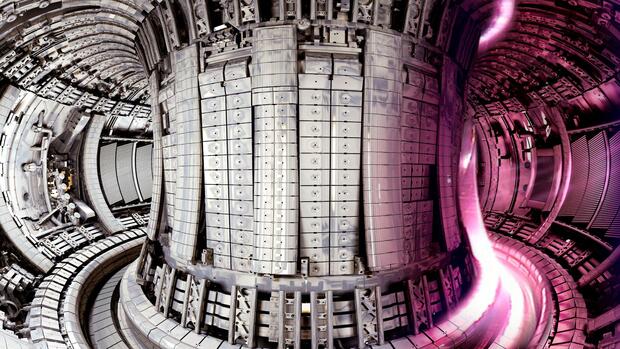Berlin For Frank Laukien, the matter is clear: fusion reactors are not a distant dream, but will soon be a tangible reality. “We aim to build the first magnetic fusion power plant in 2045. The goal is to be able to offer base load electricity, also to offer green hydrogen or derivatives for aircraft and truck traffic,” says Laukien in an interview with the Handelsblatt. The German-American is Executive Chairman of Gauss Fusion GmbH based in Hanau, Hesse.
The energy supply crisis has made everyone aware that additional renewable energy sources must be developed as quickly as possible, he says. The potential is immense: “Magnetic fusion with a full isotope cycle is such a renewable, highly efficient and safe source of energy that is capable of base load, also requires very little space and does not spoil our landscapes.”
In his day job, the physicist with a Harvard degree runs Bruker, a company that his father co-founded, which manufactures scientific instruments. Bruker is considered the world market leader in the field of magnetic resonance spectroscopy and employs 7,500 people worldwide. However, Gauss Fusion is far more than the hobby of a technically and scientifically interested multi-billionaire.
Like many scientists, companies, states and institutions, Laukien, born in 1960, is very ambitiously pursuing the goal of generating energy with nuclear fusion. Unlike in today’s nuclear power plants, atomic nuclei are fused instead of split. Theoretically, very large amounts of energy could be generated in this way – and in a climate-neutral manner.
The way nuclear fusion reactors work is modeled on the sun: Inside the sun, hydrogen nuclei fuse to form helium nuclei, releasing a great deal of energy in the process. There are no harmful by-products – in contrast to conventional nuclear fission. So far, however, all attempts to effectively mimic this fusion on Earth have failed.
Nuclear fusion always required more energy than was released during fusion. At the end of last year, researchers in the USA succeeded in carrying out nuclear fusion with a positive energy balance.
>> Read about this: US researchers report breakthrough in nuclear fusion
However, the model is far from suitable for everyday use – and also relies on nuclear fusion by laser. However, Laukien believes that the other known method of triggering nuclear fusion is more promising: “Magnetic fusion is the most developed, so that’s what we’re focusing on. Laser fusion has a much lower Technology Readiness Level (TRL). So we leave this topic to others, but research should be done in parallel here.”
The German-American billionaire wants to have the first fusion reactors designed in Germany.
(Photo: wikipedia)
Gauss Fusion works with various European companies and research institutions with experience in the field of fusion technology. In Germany, these include the Max Planck Institute for Plasma Physics (IPP) and the Karlsruhe Institute of Technology (KIT). “We apply for research funds in Germany and Europe and see ourselves primarily as a European initiative that brings together the expertise of many innovative companies and renowned research institutions,” explains Laukien. Designing the first working fusion power plant could also become very profitable for Gauss Fusion.
The Greens are convinced that the technology is coming too late
Not everyone shares the enthusiasm of the fusion researchers. The Greens, for example, take a critical view of the issue: “In reality, fusion reactors do not yet exist. That is why they are irrelevant for the urgent fight against the climate crisis,” says Harald Ebner (Greens), chairman of the Bundestag Committee on the Environment and Nuclear Safety. Despite decades of research, the idea is still waiting for its technical breakthrough. “Even experts cannot predict whether it will one day actually be ready for practical use,” says Ebner.
The high costs for research and development of the future technology are also frightening. If you still want to prevent the climate and ecosystems from reaching the tipping point, you have to “put every cent into the expansion of renewable energies, which are cheap, readily available and harmless,” says the Green politician. However, the coalition partner FDP apparently considers nuclear fusion to be worth researching and last December convened a new group of experts in the Federal Ministry of Education and Research (BMBF) to promote research in Germany.
>> Read about this: New group of experts to promote nuclear fusion in Germany
Entrepreneur Laukien, on the other hand, is convinced that he can speed up the processes. In research projects such as Iter, the international experimental nuclear fusion reactor under construction in Cadarache in southern France, he criticizes the lengthy decision-making processes in a complex, international governance structure. “This leads to immense delays, and innovative power falls by the wayside,” says Laukien.
“We have the advantage of being much more agile.” Gauss Fusion works privately and with high financial commitment, Laukien calls it “venture speed”. In three to four years, Gauss could start designing a fusion power plant using state-of-the-art high-field magnetic fusion technologies.
>> Read here: A new method could simplify the search for nuclear waste repositories
However, the development of fusion technology cannot be financed solely from venture capital. “We are convinced that it is necessary for the federal government to contribute several hundred million euros to further innovation and research via a public-private partnership over the next three to four years,” says Laukien. “When it comes to building the first full fusion power plant, we’re certainly talking about 20 billion euros, but spread over a decade, so this is a very good investment for our economy, especially to achieve our climate goals, what with coal and Gas simply doesn’t work.” The fifth power plant will then be a private business and will certainly only cost half as much.
More: What the Chancellor’s word of power on nuclear power means
